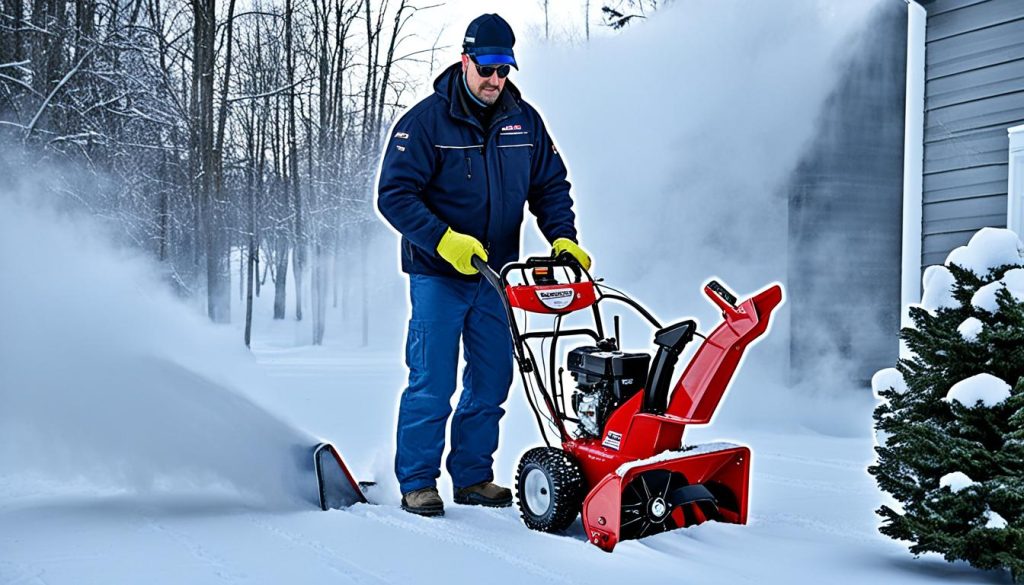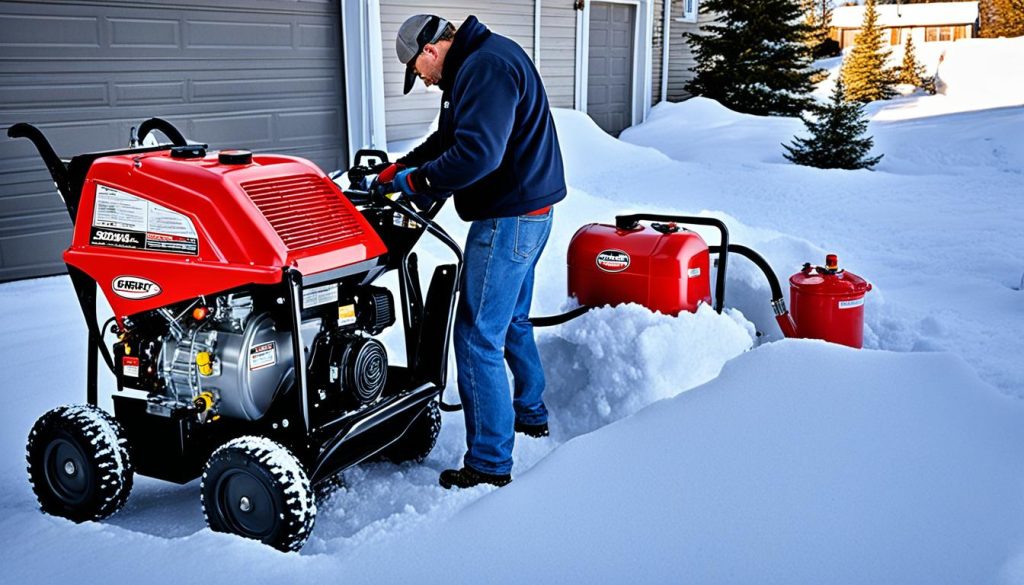Drain Gas from Snowblower: Quick & Safe Guide
Did you know that leaving untreated gas in the tank of your snowblower can lead to engine damage and costly repairs? Winter equipment maintenance is essential, and one crucial step is properly draining the gas from your snowblower. By following a few simple steps, you can ensure the longevity and performance of your snowblower, saving you time and money in the long run.
Key Takeaways:
- Regular winter equipment maintenance, including draining the gas from your snowblower, is crucial for preventing engine damage.
- Old gas can attract moisture and lead to corrosion and clogging in the engine, so it’s important to properly drain the fuel.
- Ensure you have the necessary tools and take proper safety precautions when draining gas from your snowblower.
- Draining the gas from your snowblower is just one step in preparing it for storage during the off-season.
- Regular maintenance and care of your snowblower will extend its lifespan and keep it running smoothly when you need it most.
Why Draining Gas from a Snowblower is Important
Draining the gas from your snowblower is an essential maintenance task to prevent engine damage and ensure your snowblower starts up easily next winter. Leaving fuel in the snowblower’s tank can lead to various issues, including corrosion and clogging in the engine.
Ethanol-laden gas, commonly used in snowblowers, has the tendency to attract moisture. When left untreated over time, this moisture can build up and cause rusting and corrosion in the engine components. Additionally, the ethanol can leave behind sticky residues that may clog fuel lines and carburetors, resulting in poor performance or engine failure.
By properly draining the fuel from your snowblower, you can prevent these issues and prolong the life of your equipment. Regular maintenance, including fuel removal, ensures that your snowblower remains in optimal condition and operates smoothly when you need it most.
Illustrative Diagram of a Snowblower Fuel System
| Component | Description |
|---|---|
| Fuel Tank | The container that holds the gasoline or fuel mixture used to power the snowblower. |
| Fuel Line | A tube that connects the fuel tank to the carburetor, allowing fuel to flow into the engine. |
| Carburetor | A device that mixes the fuel with air to provide the engine with a combustible air-fuel mixture. |
| Spark Plug | An electrical component that ignites the air-fuel mixture in the combustion chamber, facilitating engine ignition. |
| Engine | The main power source of the snowblower, responsible for rotating the auger and impeller to clear snow. |
Tools Needed to Drain Gas from a Snowblower
When it comes to DIY snowblower gas draining, having the right tools is essential for a smooth and successful process. Here are the tools you’ll need to drain gas from your snowblower:
- Siphon Pump: A siphon pump is a handy tool that allows you to easily extract the gas from the snowblower’s fuel tank. It consists of a hand pump and two tubes.
- Work Gloves: Wearing work gloves will protect your hands from any debris or fuel spillage during the gas draining process.
- Earplugs: Snowblowers can be loud, so it’s important to protect your hearing with a pair of earplugs.
- Eye Protection: Safety goggles or glasses will shield your eyes from any splashes or fumes that may occur while draining the gas.
- Tight-fitting Clothing: It’s important to wear tight-fitting clothing to minimize the risk of any loose fabric getting caught in the snowblower’s moving parts.
- Sturdy Boots: Choose a pair of sturdy boots that provide good traction and protect your feet during the gas draining process.
- Catch Pan: A catch pan will collect the drained gas, preventing any spills and allowing for easy disposal.
By having these essential tools on hand, you’ll be well-prepared to tackle the step-by-step gas draining guide for your snowblower.
Steps to Drain Gas from a Snowblower
Draining the gas from your snowblower is a straightforward process that you can easily do yourself. Here are the step-by-step instructions to safely remove the gas from your snowblower:
- Choose a Suitable Location: Set up your snowblower in a well-ventilated outdoor area with enough space to work comfortably.
- Prepare the Tools: Gather the necessary tools, including a siphon pump, work gloves, eye protection, earplugs, and a catch pan.
- Disconnect the Spark Plug: Before starting, disconnect the spark plug wire to prevent accidental starts.
- Insert the Siphon Pump: Insert one end of the siphon pump tube into the fuel tank of the snowblower and the other end into the catch pan.
- Squeeze the Pump: Squeeze the pump to create suction and initiate the flow of gas from the fuel tank into the catch pan.
- Drain the Gas: Continue squeezing the pump until most of the gas has been drained from the fuel tank.
- Run the Engine: After draining the majority of the gas, start the snowblower and let it run until the engine shuts off due to lack of fuel. This step helps remove any residual gas remaining in the fuel system.
By following these steps, you’ll be able to safely and effectively drain the gas from your snowblower, ensuring proper maintenance and preventing potential damage. Now that you know how to drain the gas, let’s move on to some essential safety tips for this process.
Safety Tips for Draining Gas from a Snowblower
When it comes to winter equipment maintenance, safely draining gas from your snowblower is essential. To ensure a successful and accident-free gas removal process, follow these important safety tips:
- Work in a well-ventilated outdoor area: Prioritize safety by choosing a location with proper ventilation. This will help prevent the buildup of potentially harmful fumes.
- Away from heat sources and open flames: Make sure the area where you’re draining the gas is free from any heat sources or open flames. This precaution will eliminate the risk of a fire or explosion.
- Allow the snowblower to cool down: Before starting the gas draining process, give your snowblower enough time to cool down. This will prevent any burns or injuries that could occur from hot surfaces.
- Wear appropriate safety gear: Protect yourself from potential hazards by wearing the right safety gear. This includes gloves to shield your hands, earplugs to reduce noise exposure, and eye protection to safeguard your eyes.
By following these safety tips, you can confidently and securely remove gas from your snowblower, ensuring the winter equipment remains properly maintained and ready for use.
Preparing Your Snowblower for Storage
Draining the gas from your snowblower is an important step in winter equipment maintenance, especially when preparing it for storage during the off-season. However, there are a few more essential tasks you should perform to ensure your snowblower remains in optimal condition.
After draining the gas, you should consider taking the following steps:
- Change the engine oil: Dirty or old oil can lead to decreased performance and engine damage. Before storing your snowblower, replace the engine oil according to the manufacturer’s recommendations.
- Clean and protect the exterior: Snow, ice, and debris can build up on your snowblower during use. Clean the exterior thoroughly and apply a protective coating to prevent rust and corrosion during storage.
- Inspect and replace worn parts: Check all components of your snowblower for any signs of wear or damage. Replace any worn-out parts, such as belts or spark plugs, to ensure optimal performance when you use it next winter.
- Lubricate all lubrication points: Applying lubricant to the necessary points, such as the auger shaft or chute control, will help prevent rust and keep the moving parts functioning smoothly.
Completing these tasks will help maintain the performance and longevity of your snowblower, ensuring it’s ready to tackle the snow when the next winter season arrives.
Importance of Draining Gas from Snowblower Fuel System
Draining the gas from your snowblower’s fuel system is crucial for maintaining its performance and preventing engine damage. Leaving old gas in the fuel system can have detrimental effects on the overall functionality of your snow blower, impairing its ability to start easily and run smoothly.
Over time, gasoline can degrade and form sticky residues or sludge that can clog fuel lines and injectors. This can lead to hard starting, sputtering, or poor running conditions, significantly reducing the efficiency and effectiveness of your snow blower. By draining the fuel system, you can remove these deposits, ensuring optimal fuel flow and combustion.
Regularly draining the gas from your snow blower’s fuel system is especially important during winter equipment maintenance. Storing your snow blower with untreated gas in the tank can cause the fuel to break down further, leading to more severe engine issues and potentially expensive repairs.
By taking the time to properly drain the gas from your snowblower’s fuel system, you are taking proactive steps to maintain its performance and extend its lifespan. This simple maintenance task can save you from costly repairs down the line and ensure that your snow blower is ready to tackle the next winter season without any issues.
Benefits of Draining Snowblower Fuel System:
- Prevents clogging of fuel lines and injectors
- Improves fuel flow and combustion
- Ensures easy starting and smooth running
- Prolongs the life of your snow blower
- Prevents costly engine repairs
| Issue | Consequence |
|---|---|
| Clogged fuel lines | Hard starting and poor performance |
| Blocked fuel injectors | Sputtering and uneven running |
| Sticky residues or sludge | Restricted fuel flow and reduced power |
| Engine damage | Expensive repairs and potential replacement |
Don’t neglect the importance of draining the gas from your snowblower’s fuel system. Make it a part of your regular winter equipment maintenance routine to ensure optimal performance and longevity.
Tips for Draining Gas from a Snowblower
When it comes to DIY snowblower gas draining, there are a few important tips to keep in mind for snowblower maintenance and winter equipment care. First and foremost, it’s crucial to work in a well-ventilated area to avoid carbon monoxide fumes. Make sure you’re outdoors or in a well-ventilated garage to ensure a safe environment.
Next, choose a stable surface to prevent any spills during the gas draining process. It’s important to have a firm and level ground to work on to avoid any accidents or fuel leakage. Safety should always be a top priority when performing maintenance tasks.
Lastly, don’t forget to dispose of the old fuel safely. Improperly disposing of fuel can be hazardous to the environment, so it’s essential to handle it responsibly. Look for local hazardous waste disposal facilities or contact your municipality for guidance on proper disposal methods.
- Investing Wisely: How Windows & Doors in Boost Property Value and Financial Health - April 24, 2025
- The Financial Impact of Personal Injuries: Why Legal Help Matters for Business Owners - April 16, 2025
- The Hidden Financial Costs of Domestic Assault: What Business Owners Need to Know - April 16, 2025














